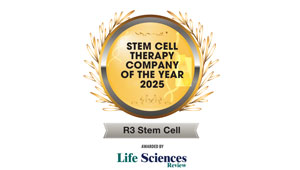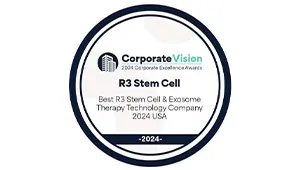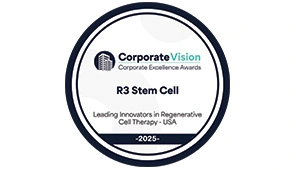How long does the pain relief from stem cell injections last?
Written by Dr. David Greene, MD, PhD, MBA on April 7, 2021
The US Leader in Stem Cell Therapy, Now in Mexico. Treatments start at $3750 for 25 million stem cells!
Special Promo: Get an additional 25 BILLION Exosomes IV with treatments over 50 million cells!”
The US Leader in Stem Cell Therapy, Now in Mexico. Affordable treatments start at $3750 for 25 million stem cells!
Special Promo: Get an additional 25 BILLION Exosomes IV with treatments over 50 million cells!”
Written by Dr. David Greene, MD, PhD, MBA on April 7, 2021
Many patients struggling with chronic conditions, such as shoulder and knee arthritis, do not have many effective treatment options. However, stem cell therapy holds great potential as a minimally invasive option compared to traditional treatments.

Stem cells are a unique type of cells since they can transform into many different types of cells depending on the tissue they are injected into. The doctor injects powerful stem cells obtained from umbilical cord blood (with donor consent) into damaged or injured tissue. Once injected, the stem cells start repairing and rejuvenating the damaged tissue, thereby relieving pain by activating the natural healing mechanisms of your own body.
Patients suffering from joint-related injuries and degenerative conditions may find better results with stem cell therapy offers without the risks and side effects of surgery.
After a stem cell therapy injection, the stem cells continue to work and form new cells in the target tissue for up to one year. However, patients start experiencing relief within 1–2 weeks following the stem cell therapy procedure. After treatment, patients can continue with physical therapy to further prolong pain relief.
The conventional treatments for degenerative joint conditions include steroid injections, medications, lifestyle changes, and finally, surgery. While some of these treatments may help with acute pain, they do not work well long-term in degenerative injuries and conditions as the condition continue to worsen over time.
Eventually, surgery remains the only option for most patients.
However, surgery itself is potentially risky and carries several risks of complications and side-effects.
On the other hand, patients who undergo stem cell therapy for their joint conditions start experiencing relief within a few weeks and the relief lasts longer than many conventional treatments without any risks or side-effects.
The length and effectiveness of pain relief from stem cell injections can vary depending on several factors:
Stem cell injections are increasingly used to treat a variety of orthopedic and degenerative conditions, such as:
For many of these cases, stem cell therapy offers pain relief that can last for 6–12 months or longer, with many patients reporting sustained improvement and reduced dependency on medications.
Most patients require only one injection, though some may benefit from a second treatment depending on severity.
Stem cell injections are typically performed with local anesthesia and cause only minor discomfort.
While not permanent, the results often last much longer than steroid shots or other conservative treatments.
In many cases, stem cell therapy helps delay or avoid the need for joint replacement surgery.
If you’ve tried physical therapy, medications, or even steroid injections without long-term success, stem cell therapy may offer the next best step—especially for those seeking:
Speak to a regenerative medicine specialist to determine if you’re a candidate.
Stem cell therapy stands out as a promising, non-surgical solution for managing chronic pain and joint damage. It not only treats symptoms but helps regenerate tissue at the cellular level—offering results that can last up to a year or longer, with fewer risks and shorter recovery time than traditional surgery.
Contact US

Dr. David Greene
MD, PhD, MBA
Dr. David Greene, MD, PhD, MBA, is a pioneering leader in regenerative medicine and healthcare marketing. As a residency and fellowship-trained orthopedic surgeon, Dr. Greene transitioned from clinical practice to become the founder and CEO of R3 Stem Cell and US Lead Network, where he has revolutionized patient care and medical practice growth through innovative therapies and digital marketing strategies. He has authored two influential books on healthcare internet marketing, ranks among the top expert authors globally, and has been featured on the cover of Corporate Vision magazine for his impact on global regenerative therapies. Beyond his professional achievements, Dr. Greene is passionate about education, compassion, and continuous innovation.

About R3 Stem Cell Mexico
Follow Us
Quick Links
Disclaimer
Stem cell therapy is considered experimental and is regulated by the U.S. Food and Drug Administration (FDA), but it is not FDA-approved. R3 Stem Cell does not offer stem cell therapy as a cure for any medical condition. No statements made on this site have been evaluated or approved by the FDA. This site does not provide medical advice. All content is for informational purposes only and is not a substitute for professional medical consultation, diagnosis, or treatment. Reliance on any information provided by R3 Stem Cell, its employees, others appearing on this website at the invitation of R3 Stem Cell, or other visitors to the website is solely at your own risk. R3 Stem Cell does not recommend or endorse any specific tests, products, procedures, opinions, or other information that may be mentioned on this website. R3 Stem Cell is not responsible for the outcome of your procedure. The FDA considers stem cell therapy experimental at this point.
Contact Us











Copyright © 2016 – 2025 R3 Stem Cell